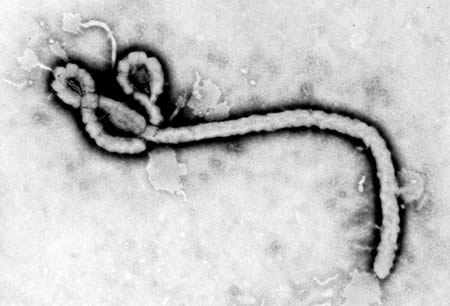Resumen
Definición
Anamnesis y examen
Principales factores de diagnóstico
- presencia de factores de riesgo
- exposición a un orthoebolavirus en los últimos 21 días
- fiebre
- mialgia
- inyección conjuntival
Otros factores de diagnóstico
- fatiga
- anorexia
- diarrea
- vómitos
- cefalea intensa
- dolor abdominal o acidez
- tos, disnea, dolor torácico
- dolor de garganta
- postración
- taquipnea
- erupción maculopapular
- sangrado
- hepatomegalia
- linfadenopatía
- hipo
- taquicardia
- hipotensión
- signos neurológicos
Factores de riesgo
- vivir, trabajar o llegar de una zona endémica en los 21 días previos
- contacto con fluidos corporales infectados
- exposición laboral
- matanza de animales o consumo de carne de animales infectados (o posiblemente infectados)
- bioterrorismo
Pruebas diagnósticas
Primeras pruebas diagnósticas para solicitar
- reacción en cadena de la polimerasa con transcriptasa inversa (RT-PCR)
- investigaciones de la malaria
Pruebas diagnósticas que deben considerarse
- niveles de electrolitos séricos
- creatinina sérica y urea
- lactato en sangre
- GSA
- hemograma completo (HC)
- estudios de coagulación
- análisis de orina
- pruebas de función hepática (PFH)
- nivel de amilasa sérica
- glucosa sérica
- hemocultivos
- ensayo de inmunoabsorción enzimática (ELISA) de captura de antígeno
- serología
- radiografía de tórax
Algoritmo de tratamiento
Colaboradores
Autores
Catherine F. Houlihan, MSc, MB ChB, MRCP, DTM&H
Clinical Lecturer
University College London
Honorary Clinical Lecturer
London School of Hygiene and Tropical Medicine
London
UK
Divulgaciones
CFH declares that she has no competing interests.
Manuel Fenech, MD, MRCP, DTM&H
Specialist Trainee in Infectious Diseases
Royal Liverpool University Hospital
Liverpool
UK
Divulgaciones
MF declares that he has no competing interests.
Tom E. Fletcher, MBE, MBChB, MRCP, DTM&H
Wellcome Trust/MoD Research Fellow
Liverpool School of Tropical Medicine
Liverpool
UK
Divulgaciones
TEF is an author of a number of references cited in this monograph. TEF is a consultant/expert panel member to the World Health Organization, and is funded by the UK Surgeon General and the Wellcome Trust. TEF has received research grants from the Medical Research Council and the UK Public Health Rapid Support Team (UK-PHRST).
Agradecimientos
Dr Catherine F. Houlihan, Dr Manuel Fenech, and Dr Tom E. Fletcher would like to thank Dr Nicholas J. Beeching, a previous contributor to this topic, and Dr Colin Brown (Infectious Disease Lead, Kings Sierra Leone Partnership) for his helpful comments and insights.
Divulgaciones
NJB was partially supported by the National Institute of Health Research Health Protection Unit in Emerging and Zoonotic Infections at the University of Liverpool and Public Health England. NJB is an author of references cited in this topic. CB declares that he has no competing interests.
Revisores por pares
William A. Petri, Jr, MD, PhD, FACP
Wade Hampton Frost Professor of Epidemiology
Professor of Medicine, Microbiology, and Pathology
Chief
Division of Infectious Diseases and International Health
University of Virginia
Charlottesville
VA
Divulgaciones
WAP declares that he has no competing interests.
Luis Ostrosky-Zeichner, MD, FACP, FIDSA, FSHEA
Professor of Medicine and Epidemiology
UT Health Medical School
Medical Director of Epidemiology
Memorial Hermann Texas Medical Center
Houston
TX
Divulgaciones
LO-Z declares that he has no competing interests.
Stephen Mepham, MRCP (UK), FRCPATH, DTM&H, MD
Consultant in Microbiology and Infectious Diseases
Royal Free London NHS Foundation Trust
London
UK
Divulgaciones
SM declares that he has no competing interests.
Agradecimiento de los revisores por pares
Los temas de BMJ Best Practice se actualizan de forma continua de acuerdo con los desarrollos en la evidencia y en las guías. Los revisores por pares listados aquí han revisado el contenido al menos una vez durante la historia del tema.
Divulgaciones
Las afiliaciones y divulgaciones de los revisores por pares se refieren al momento de la revisión.
Referencias
Artículos principales
World Health Organization. Clinical care for survivors of Ebola virus disease: interim guidance. Apr 2016 [internet publication].Texto completo
World Health Organization. Guidelines for the management of pregnant and breastfeeding women in the context of Ebola virus disease. 2020 [internet publication].Texto completo
World Health Organization. Infection prevention and control guideline for Ebola and Marburg disease. Aug 2023 [internet publication].Texto completo
World Health Organization. Optimized supportive care for Ebola virus disease. July 2019 [internet publication].Texto completo
Lamontagne F, Fowler RA, Adhikari NK, et al. Evidence-based guidelines for supportive care of patients with Ebola virus disease. Lancet. 2018 Feb 17;391(10121):700-8.Texto completo Resumen
World Health Organization. Clinical management of patients with viral haemorrhagic fever: a pocket guide for the front-line health worker. Feb 2016 [internet publication].Texto completo
World Health Organization. Therapeutics for Ebola virus disease - Democratic Republic of the Congo. Aug 2022 [internet publication].Texto completo
Artículos de referencia
Una lista completa de las fuentes a las que se hace referencia en este tema está disponible aquí.
El uso de este contenido está sujeto a nuestra cláusula de exención de responsabilidad

